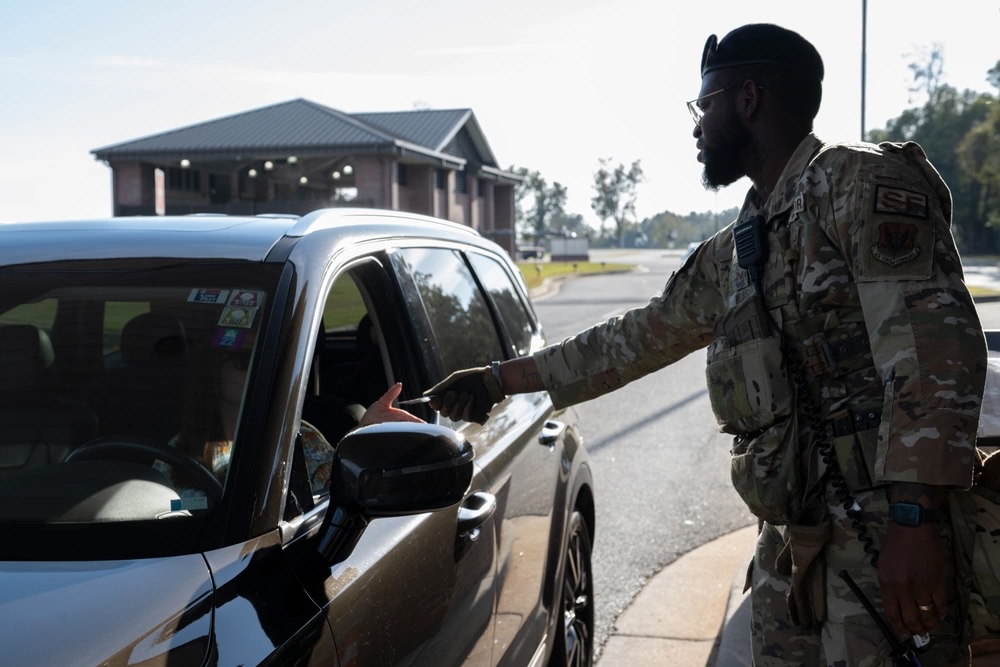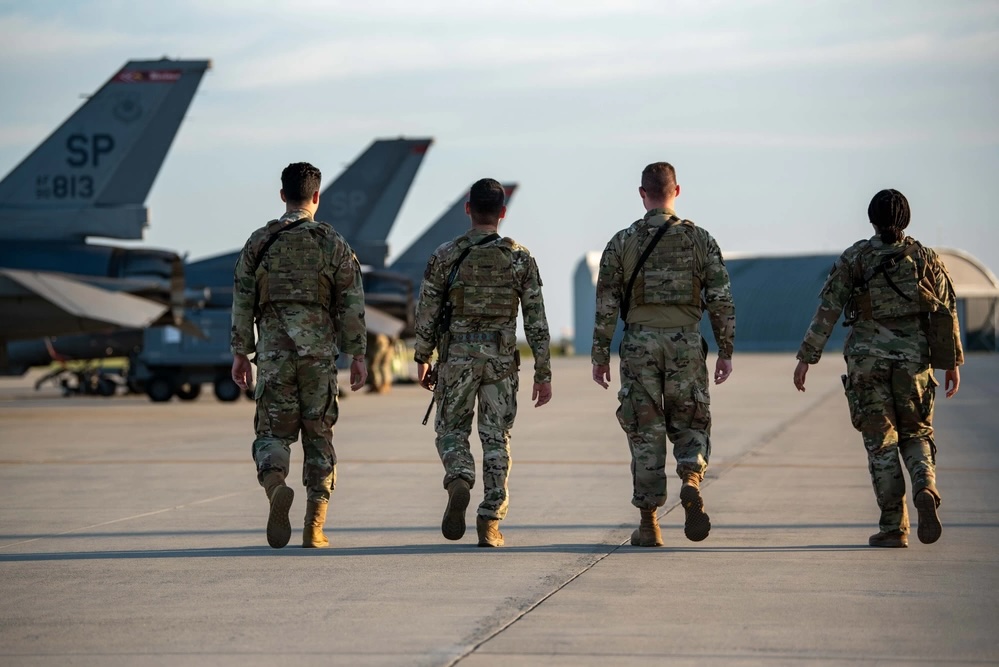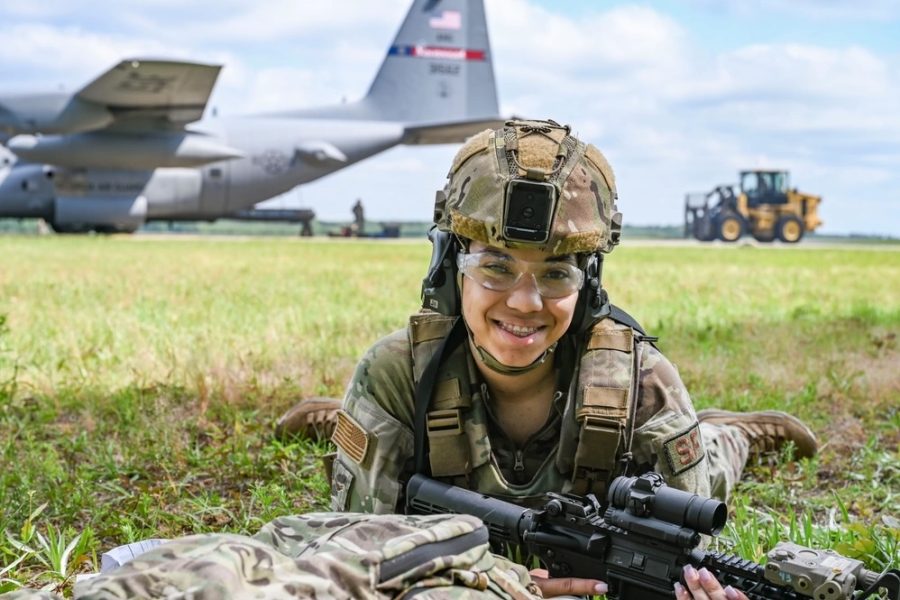With more than 38,000 Airmen, security forces is the largest career field in the Air Force. It is also one of the most overworked, with a higher suicide rate than most other job specialties. A new paper from a lifelong Defender proposes a solution: give base leaders more authority to shape their own security procedures. The result, he argues, may be more efficient systems that would make Air Force bases safer and give defenders more time with their friends and families.
“Today, many SF members at Air Force installations worldwide have limited operational effectiveness due to redundant security concepts and restrictive security procedures,” wrote Senior Master Sgt. Brandon Dinkins, a 19-year Defender, in a paper published in the fall issue of Air University’s Air & Space Operations Review.
“A new security management approach for SF posting and response can help create a more lethal, educated, effective, and ready force to meet the dangerous threats of today,” wrote Dinkins, the superintendent of operations and training for the 45th Security Forces Squadron at Patrick Space Force Base, Fla.
Back-Breaking
Defenders have a lot on their plates. As the Air Force’s law enforcement body, they write tickets, investigate on-base incidents, and patrol installations. But they also have to maintain infantry combat skills in order to protect the base from attacks. Those duties add up, especially when training, temporary duty travel, and deployments are factored in.
“We try to adhere to eight-hour shifts, but once we can’t maintain that policy, we often move to a 12-hour shift schedule,” Dinkins told Air & Space Forces Magazine, emphasizing that his views do not necessarily represent those of the Air Force or the Department of Defense. “That creates duty instability, mental fatigue, physical injury, and more on-the-job accidents.”
Dinkins pointed to himself as an example. He loves his job, but he also has back issues from working 13-hour shifts in body armor, and many of his colleagues feel similar physical and mental pain.
“A lot of Defenders seek out mental health for reasons that are compounded by working 12-hour shifts; it might create strains on your marriage or your personal life,” he said.

Reactive vs. Proactive
Security forces Airmen pull shifts at posts determined by security requirements. The problem is that many of those requirements come from Headquarters Air Force, and the one-size-fits-all approach does not work for all installations. For example, Joint Base Andrews, Md., has a special focus on providing security for the president and other senior leaders, while Patrick Space Force Base has a waterfront and a boat security mission.
The top-down requirements also emphasize protecting critical assets such as flightlines and aircraft. These are important to protect, but they also usually have more built-up security infrastructure in the form of cameras, alarms, fences, and other systems to delay and deter intruders. Current requirements do not leave much space for securing the rest of the base.
“I might have five patrols available, four of which might be strictly tied to a resource such as the flightline or a space-based system,” Dinkins said. “I might have only one patrol available to respond to any other incident on that base, whether it be a high-risk traffic stop, a threat at the gate, or a shoplifting case.”
Dinkins would prefer a proactive stance where defenders can deter crime by maintaining a larger presence in high-population areas such as base housing, the gates, the commissary, and the base exchange (BX).
Gaps in perimeter security can also have an effect on the safety of those critical assets deeper inside the fence line, such as in February when an intruder entered Andrews, and in 2021, when a different intruder made it inside a C-40 transport jet before being arrested.
“Security Forces can utilize patrols as high-visibility deterrence, which helps increase the probability of detecting and deterring criminal acts and security breaches,” Dinkins wrote.
A more proactive security posture would have to be informed by data and intelligence. For example, Dinkins has visited Army bases where a criminal intelligence analyst studies peak traffic, peak crime times, and other factors that military police use to guide their patrols.
“If we know that there is a higher probability of theft at the BX, or a large number of break-ins at the gym around 5 o’clock, those statistics help you develop a proactive strategy,” he said.

Delegate Down
Theoretically, defense force commanders (DFCs) can seek waivers to form tailored security strategies, but there is an unspoken taboo against it.
“It comes down to optics, right? Why can’t you meet requirements?” Dinkins said. “That might not totally be the case, but I believe people feel a bit of peer pressure to maintain the status quo.”
Defenders are not the only military community with rigid, top-down requirements, but allowing installation leaders to tailor their security posture could save man-hours at a time when the Air Force is strapped for personnel.
“Tracking criminal trends and threats allows DFCs to utilize their force more effectively, thus reducing inefficient policing and security posting,” Dinkins wrote. “DFCs can reallocate forces to other base patrolling activities and not restrict area security patrols to resources where infrastructure and layered defense can deter and delay adversarial threats.”
Those strategies could be further augmented by automated or autonomous systems—such as the robot dogs brought on for testing last year at Patrick Space Force Base. Besides making installations more secure, Dinkins hopes such changes could also give some time and purpose back to Defenders.
“Nothing’s worse than feeling like you are wasting your time,” he said, adding that many of the ideas in the paper were inspired by years of spit-balling on post with other Defenders. “I’ve been on post plenty of times asking ‘Why am I here?’ Sometimes as Defenders we are not even told what we’re guarding. It is good to know why we do things.”
Dinkins said now is the time to optimize security forces. The last time the career field underwent major changes was in the wake of the 1996 Khobar Towers bombing at Dhahran Air Base, Saudi Arabia, where 19 Airmen died and hundreds more were wounded.
“We have to be proactive and deliberate in our ability to stay ahead and think ahead,” he said. “I would rather make changes before it was needed than after it was needed.”

